Affiliate links on Android Authority may earn us a commission. Learn more.
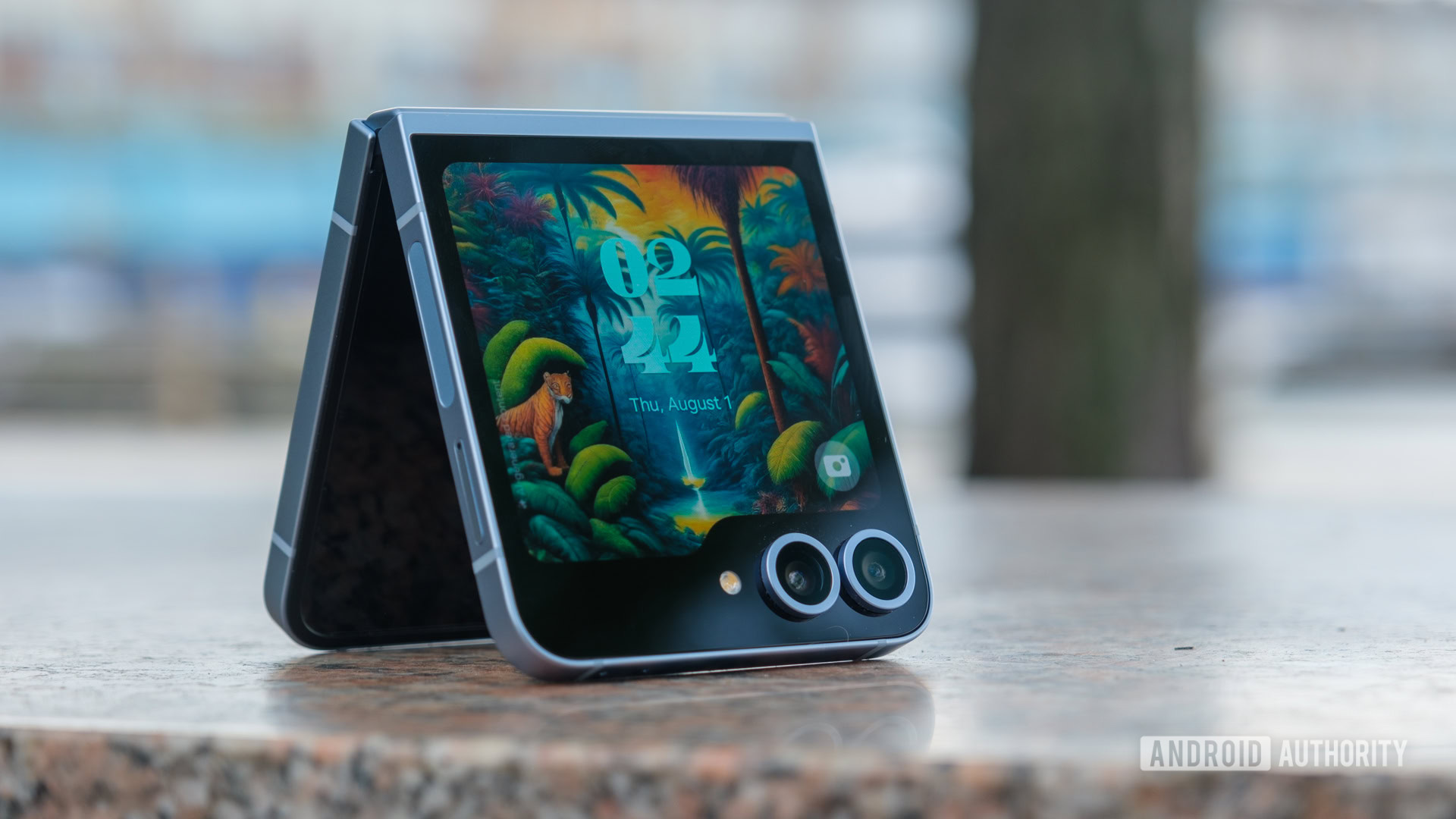

I didn't want to like the Galaxy Z Flip 6, but it keeps winning me over
February 10, 2025

Samsung Galaxy Z Flip 6
MSRP: $1,099.99
What we like
What we don't like

Samsung Galaxy Z Flip 6
I don’t usually come into a review expecting to be underwhelmed — especially not when it’s a foldable flip phone, my favorite flavor of Android experience — but that’s exactly what happened with Samsung’s Galaxy Z Flip 6. As much as I liked previous generations of the original reborn flip phone, I’ve been more impressed by Motorola’s Razr Plus line in recent years and figured that Samsung wouldn’t win me over unless it made a few key changes to its sixth-generation flip phone, especially after a $100 price hike over the Galaxy Z Flip 5.
Since heavily testing the Galaxy Z Flip 6, though, I’ve begun to understand why Samsung didn’t make those sweeping changes. I’m realizing that maybe it’s not a step towards perfection but a refinement of a clamshell-style foldable phone that was already the best for most people. It still has some work to do to reach the peak of what this form factor could do, but the Galaxy Z Flip 6 is a much better flip phone than I wanted to give it credit for.
Samsung’s design is my biggest problem
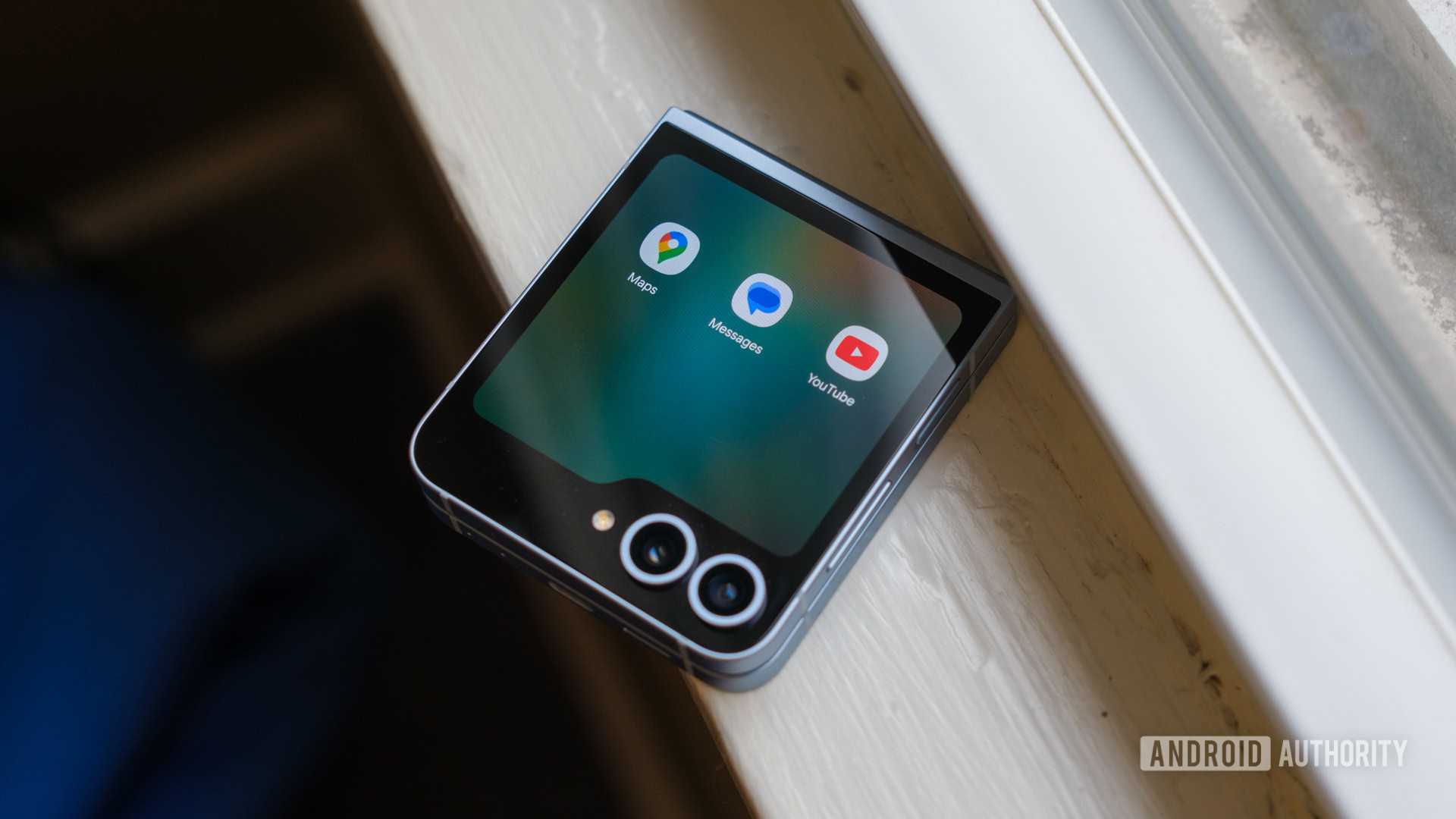
Perhaps I wanted to dislike the Galaxy Z Flip 6 right off the bat because of something I had previously liked about Samsung’s flip phones — its design. It’s simply tougher to get excited about a millimeter-for-millimeter, gram-for-gram copy of a phone I’ve already reviewed (this is my third consecutive year testing the Z Flip), even if that phone was the best-built flip phone to date. Which is exactly what happened here.
Simply put, if you’ve seen, held, or used the Galaxy Z Flip 5, you’ve pretty much had 90% of the Galaxy Z Flip 6 experience. It has the same 3.4-inch Super AMOLED Flex Window that Samsung introduced on its predecessor, the same Armor Aluminum frame, and the same panels of Gorilla Glass Victus 2 protecting the outside. Sure, they’ve swapped from glossy to matte (or maybe satin) finishes — which is a bigger improvement than I would have expected — but the broad strokes of the design are still there. Weirdly, I felt disappointed.
I know, it’s silly to think that way. This is, after all, the most durable flip phone on the market right now, with an official IP48 rating (the four is new, but it’s still not dust resistant) and a premium mix of materials that should stand up to daily life without issue (though you should still buy a case for something this fragile). My disappointment with the retread design is purely aesthetic — I’ve had no problems taking the Galaxy Z Flip 6 on actual adventures over the last few weeks. It’s come with me on sweaty, rainy runs through the remnants of a tropical storm, sat around a campfire and tumbled into the dirt while camping, and been propped up on all manner of surfaces around Baltimore to grab selfies of my various running friends in Flex Mode.
I also have to give Samsung credit for one thing — it finally found a way to shrink its display crease, even if it’s only a little bit. Yes, you’ll still see it if you hold the Galaxy Z Flip 6 at just the right angle, but it’s shallower than ever before, and I stopped noticing it after just a few days of usage. The primary 6.7-inch Dynamic AMOLED panel surrounding the crease might not have changed much — it’s a little brighter this year at 2,600 nits of peak brightness — but it already offered a sharp Full HD Plus resolution and 120Hz refresh rate that matches its traditional flagship cousins.
Samsung's build quality is second to none, but it's let down by an underwhelming Flex Window experience.
So far, so good, right? Well, yes. I can’t protest that the Galaxy Z Flip 6 is well-built and feels premium from top to bottom. However, I can take issue with the fact that Samsung didn’t fix its one glaring weakness from last year — using the Flex Window is still far more complicated than it needs to be. You still need Good Lock and MultiStar to open most apps on the cover screen, and I still don’t want to have to use them in such an arbitrary way. To make matters worse, Samsung’s flip phone seems to have fewer pre-loaded widgets than ever before. Mine only showed the calendar widget during the setup process, leaving me to figure out how to drag and drop everything else afterward. And yes, I’m sure some users who love to customize every last inch of their One UI 6.1.1 experience will love that, but it makes it harder to recommend the Galaxy Z Flip 6 as a first flip phone.
What I would have liked to see Samsung do is follow Motorola’s lead when it comes to the cover screen. The Motorola Razr Plus (2024) ships with a well-organized set of widgets, so you can check the weather, keep up with your calendar, and get set up on Spotify with just a few taps. Add an app drawer, and you can open almost any app you download on Motorola’s 4.0-inch AMOLED panel. Motorola has also shored up its flip phone’s hinge, making the build quality gap between the Razr Plus and Galaxy Z Flip 6 tighter.
And yet, once you get all your widgets laid out and your app drawer (or two) set up, you begin to see why Samsung kept things as they were. Its weather widget is perfectly sized for the Flex Window, and the calendar widget is just large enough to check the date without a cluttered breakdown of events. I’m finally starting to understand the folder-shaped display, too — it’s nice not to worry about resizing apps around the camera cutouts, even if they do feel somewhat cramped a lot of the time.
It’s tough to top a “For Galaxy” chipset
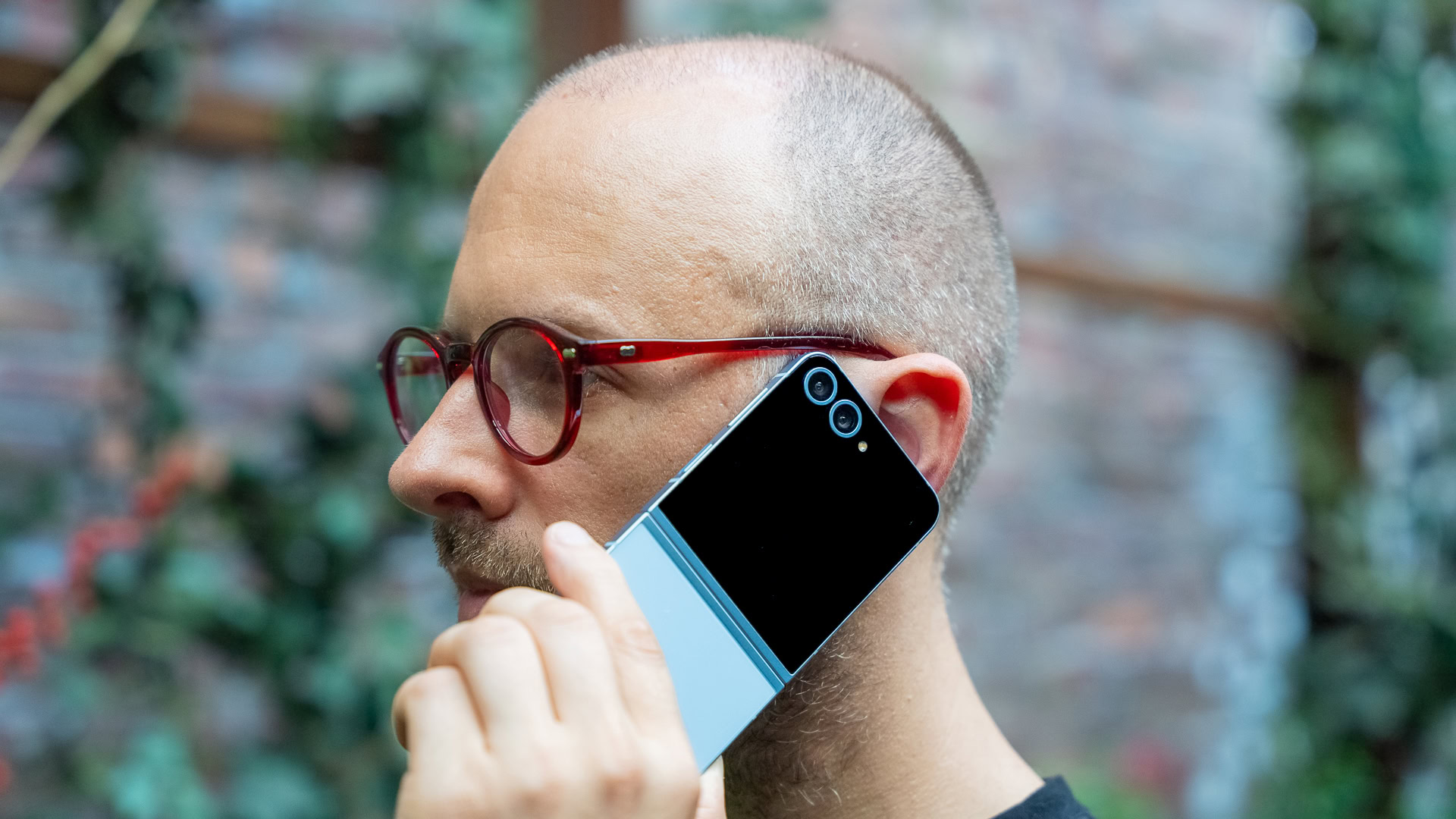
Design quirks aside, the Galaxy Z Flip 6 is a beast under the hood. There’s no good way to argue with the extra power Qualcomm’s overclocked Snapdragon 8 Gen 3 for Galaxy provides. This year, it’s backed by 12GB of RAM on both configurations — up from 8GB on the Galaxy Z Flip 5 — and its 256GB of base storage should be the standard offering across all flagships at this price point (stares at Google intently). I can’t even pretend I wanted more out of the Galaxy Z Flip 6 in this category — it’s already a better performer than its flip phone competition.
As always, I ran it through our rigorous set of benchmarks, testing the CPU, GPU, and battery life against its predecessor with a Snapdragon 8 Gen 2 for Galaxy chipset and the Razr Plus with a Snapdragon 8s Gen 3, which is Samsung’s only meaningful competition in the US. It easily outpaced both with the highest single and multi-core Geekbench 6 scores and sustained the best performance across 20 runs of 3D Mark’s Wild Life test — even if it soared to the highest temperature by the end.
Of course, benchmarking performance only tells part of the story since most people aren’t just going to use their phones for CPU or GPU-intensive tasks. That said, the Galaxy Z Flip 6 continues to soar through day-to-day tasks, too, and its Snapdragon 8 Gen 3 for Galaxy chipset acts as the powerhouse behind a (slowly) growing slate of Galaxy AI features. I’ve had no problems trusting the Galaxy Z Flip 6 as my secondary device on T-Mobile’s network throughout testing, using it to stream Spotify over Bluetooth to my Galaxy Buds 3 Pro and relying on Google Maps to navigate me through a four-and-a-half-hour drive from Maryland to upstate New York for a camping trip.
The Galaxy Z Flip 6 doesn’t mind the occasional gaming session here and there, either, but I’m not sure it’s my favorite phone for that purpose. Although it can keep up graphically, as the Wild Life stress test suggested, it does get warm pretty quickly, making the top half of the phone uncomfortable to hold. It’s not as bad if you’re into casual puzzles played vertically, but if you’re playing Railbound or Asphalt 9: Legends in their intended horizontal layout, one hand will get warm quickly. Unfortunately, the compact flip phone form factor means there’s not much space for the Galaxy Z Flip 6 to vent that heat, either, so it usually takes quite a few minutes of idling before it’s comfortable to use again.
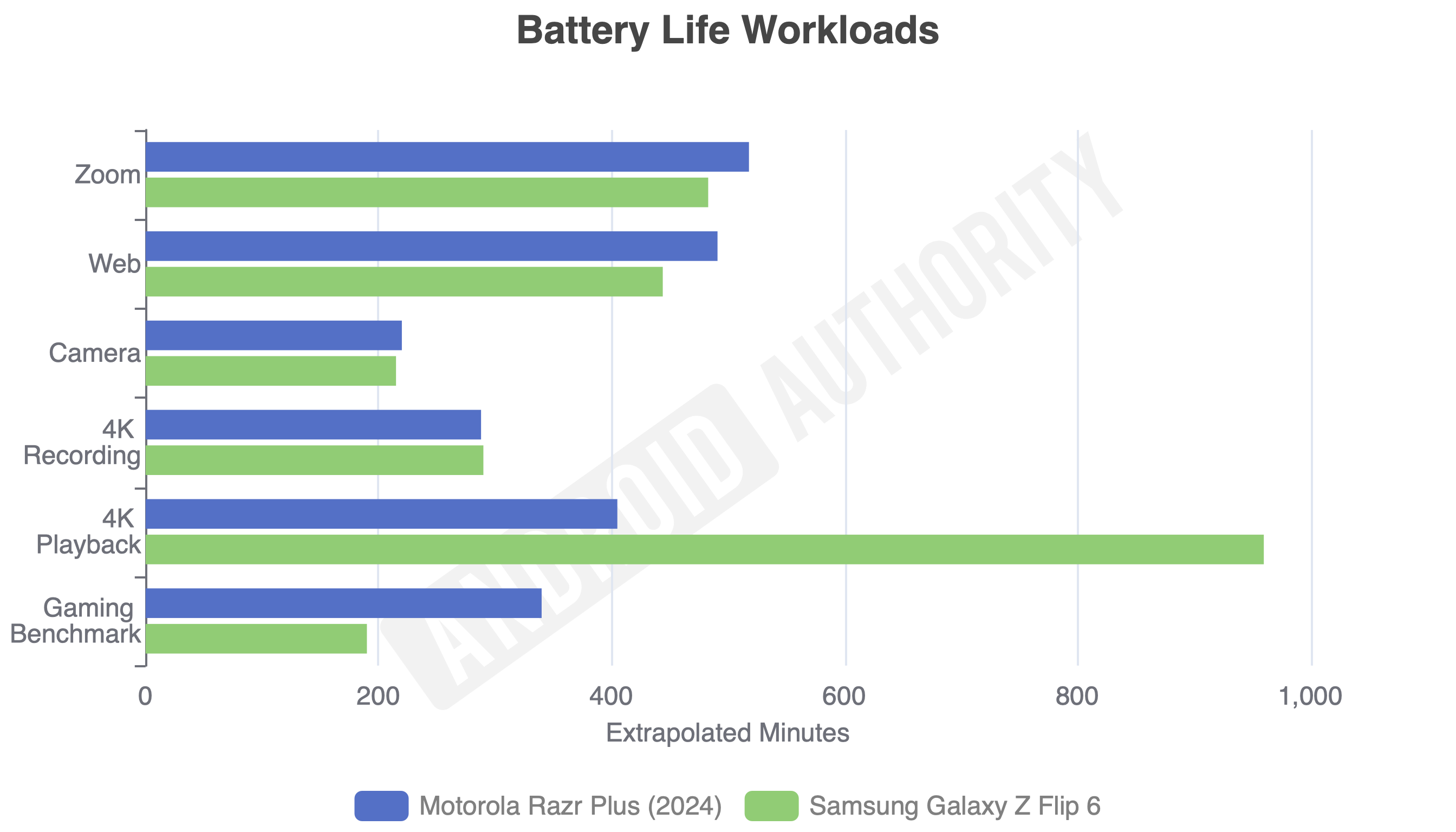
Thankfully, with a well-mixed day of usage, you shouldn’t notice the warmth from gaming all that much. Our overall battery drain test told pretty much the same story, with the Galaxy Z Flip 6 handing in a much stronger performance across the day-to-day sections like web browsing and using the cameras — not to mention an astronomical score on 4K video playback. I’m not sure I’d reach for the Galaxy Z Flip 6 if I were going to watch videos all day long, but at least it’s nice to know that you could if you wanted to.
Once you drain the 4,000mAh cell, Samsung offers some familiar charging options: 25W wired charging and 15W wireless charging. These are exactly the same speeds that the Galaxy Z Flip 5 offered, and it takes about the same 85 minutes to power back to a full charge—just make sure you bring your own Samsung Galaxy charger or any charger that supports USB PD PPS, as there isn’t one in the box.
Of course, the real purpose of the Snapdragon 8 Gen 3 for Galaxy chipset is one feature that I’m not totally sure of just yet…
I’m still not entirely sold on Galaxy AI
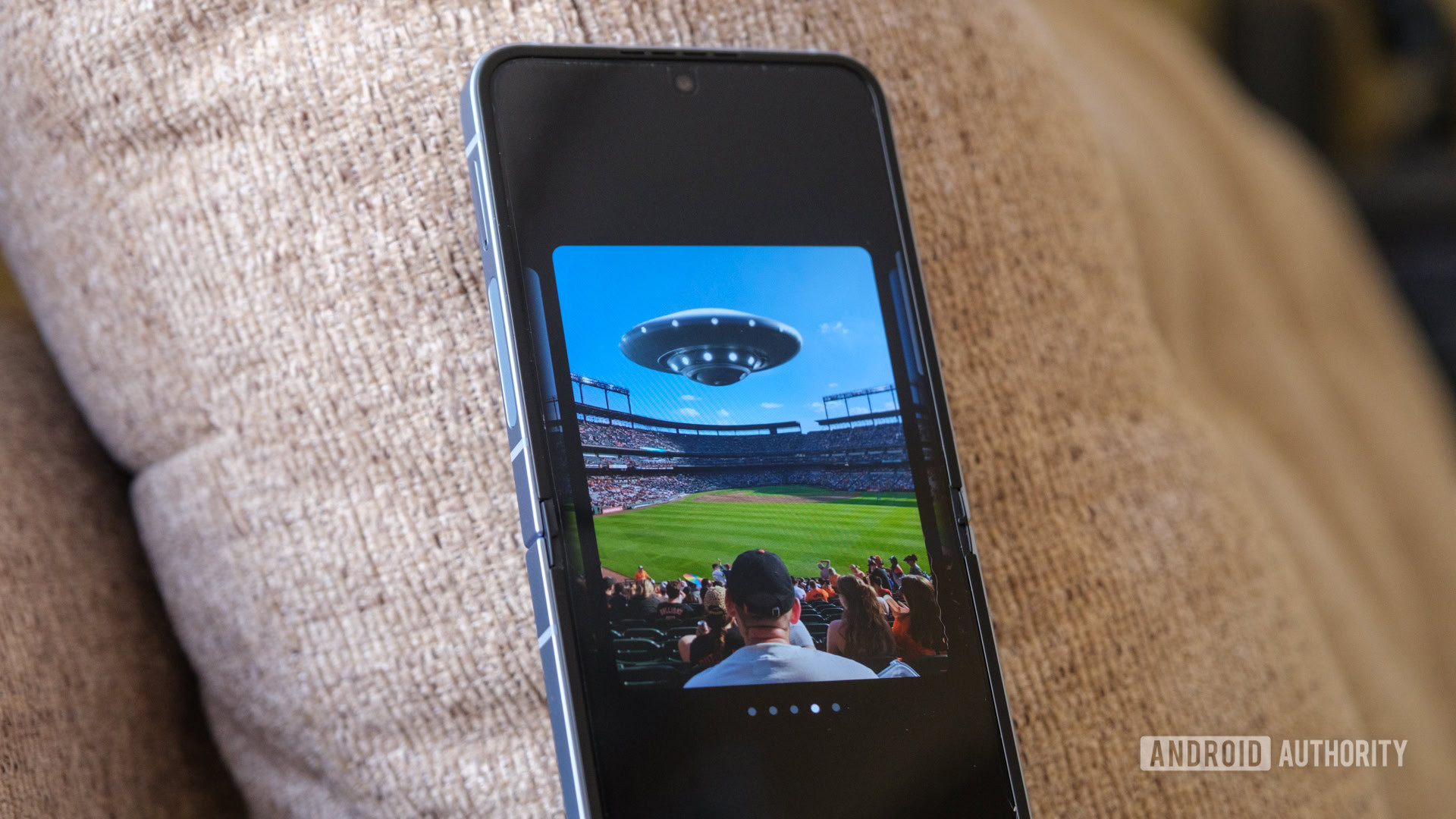
Despite everything else on the Galaxy Z Flip 6 that’s changed my mind and worked in the phone’s favor, I’ve yet to be convinced by the current state of Galaxy AI. I know that Samsung has big dreams for its artificial intelligence platform and will certainly improve over time, but it’s not there yet as of One UI 6.1.1. It’s not worth the extra $100 that Samsung tacked onto the price of its latest flip phone, either. Also, I’m still waiting for One UI 7 to drop now that I’ve spent a few weeks with it on the Galaxy S25 series. So far, though, my Galaxy Z Flip 6 has only received several security patches.
Of course, the Galaxy AI lineup includes some good features, but I’m not sure they should be the key selling points for a $1,100 phone just yet, especially when one of the best AI features, Circle to Search, doesn’t work on the Flex Window even if you add all of the Good Lock complications. At the same time, I think Samsung should probably be pushing other features like Auto Zoom — which tracks you and automatically adjusts the zoom of the cameras when in Flex Mode — a bit harder since it feels like something that the Galaxy Z Flip series should have added years ago. Positioning my Galaxy Z Flip 6 on a flat surface for a selfie with friends and not having to manually tweak the zoom is perhaps the second most exciting thing for my iPhone-toting friends, not far behind the simple act of pulling the phone out of my pocket and unfolding it.
I'm into Galaxy AI for health-tracking. Creativity? Not so much.
What gives me some hope for Galaxy AI and its future usefulness is the new slate of health-tracking features. I’ve been using the Galaxy Watch 7 alongside the Galaxy Z Flip 6, and I’ve begun to check the Energy Score almost daily. It works a lot like Garmin’s Body Battery but provides you with simple, actionable ways to boost your score, and it feels like one of the most practical uses for AI so far. As I jump into the swing of marathon training, my Energy Score is pretty dire, but at least I know there’s more to fixing it than just getting more sleep.
Where I’m not at all convinced by Galaxy AI, however, is with generative AI. I just don’t see Portrait Studio (featuring a very expensive cameo by Sydney Sweeney at Unpacked) as anything more than a way to generate cartoons that look vaguely like your loved ones while training Samsung’s models on your friends and family. Sure, it’s fun to see people you know as cartoons or sketches, but I’ve yet to even save an image that the Portrait Studio has generated. Sketch to Image is about the same — I had fun drawing a UFO over Orioles Park at Camden Yards, but I don’t think I’ve looked at the resulting image again since I made it.
Of course, the Galaxy Z Fold 6 suits Sketch to Image a little better due to the S Pen support, but it’s broadly emblematic of Samsung’s push into “fun” uses for AI, which isn’t anywhere near as useful when compared to the more practical implementations Google is working on with the Pixel 9 series. Now I just need a Pixel Flip… but I digress.
If Samsung wants me to trust Galaxy AI, let alone use it, it has to dive further into the productivity side and leave the generative creativity behind, except when I want to make a new wallpaper.
The Galaxy Z Flip 6’s cameras aren’t fancy, but they’re great
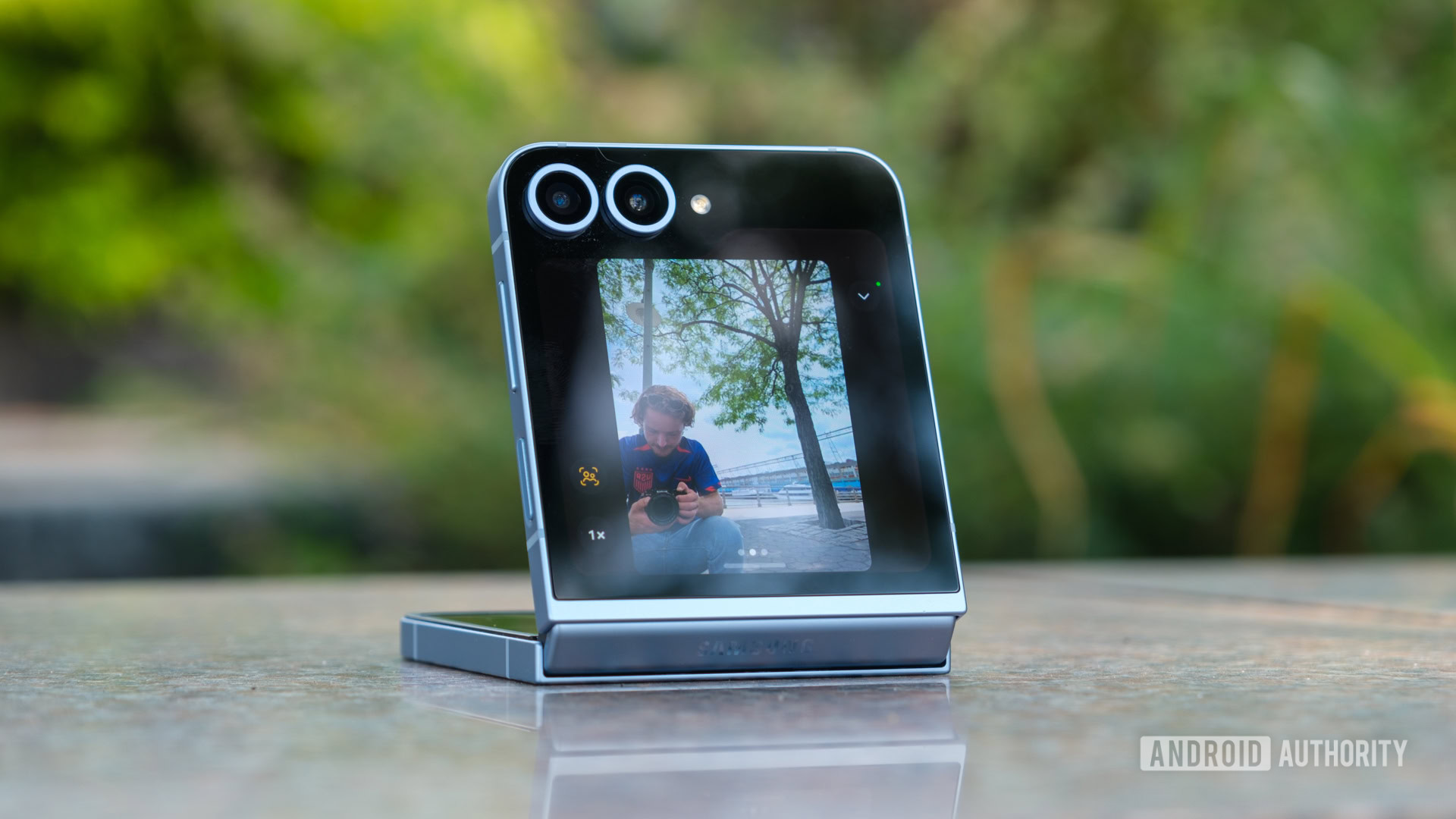
I’ve previously complained that Samsung needed to bring a telephoto sensor to its Galaxy Z Flip, but I think I’ve changed my tune. Funny enough, it’s not because of anything that Samsung changed, but rather because Motorola proved that the grass isn’t always greener on the other side. It swapped from the wide and ultrawide pairing we often see on flip phones to a wide and telephoto duo on its latest Razr Plus (2024), and I didn’t like it as much as I thought I would. While it’s cool to punch in for up to 30x zoom on a flip phone, the quality at those longer lengths isn’t great, nor can you zoom beyond 1x when using the Razr Plus closed, making it not nearly as flexible as it first seemed.
Samsung, on the other hand, wisely stayed the course with its Galaxy Z Flip 6, and the result is a foldable camera phone that’s just a little bit better than before. It traded its previous 12MP primary sensor for a higher-resolution 50MP version with a slightly shorter focal length (wider field of view) and paired it with the same 12MP ultrawide sensor that the Galaxy Z Flip 5 had. It’s not a revolutionary pairing, but it’s perfectly matched to the compact form factor and offers much more flexibility when using the phone while closed.
Of course, I used that primary sensor for most of my shooting, but I haven’t been as shy about trusting the ultrawide camera as usual. Here are just a few of the shots I’ve grabbed during my weeks with the Galaxy Z Flip 6, as well as some thoughts on things I’ve noticed:
Unsurprisingly, Samsung knows how to handle a 50MP primary sensor. I knew it would probably hand in a decent image given good lighting, just like it did in the shot of the life preserver and the one taken in the middle of my hometown’s main street. The red of the life preserver is spot on, while the Galaxy Z Flip 6 accurately separated the subject itself from the horizontal rails behind it. There are a few quirks with the shot down the street like the purple flare coming off of the sun and a few overly punchy green colors, but I’m still happy enough with the details in the shops and cars.
Samsung’s updated zoom capability impressed me, too. I dropped by the first NFL preseason game of the year and needed 4x zoom to capture the players cleanly. Given the somewhat shaky preview image, I wasn’t expecting much, but the Snapdragon 8 Gen 3 for Galaxy cleaned up the players and details pretty nicely — even if this is one spot where a telephoto lens might have helped.
Anyway, I mentioned that I’ve been using the ultrawide sensor more than usual, and it’s true. I’ve embraced that Samsung’s 0.6x field of view makes things look even bigger than they already are, which is why giant Connect Four looks, well, giant. There’s maybe not a ton of excitement to pull out of these shots — I do notice a slight distortion in the tree behind Connect Four, and the gravel to the left of the chocolate factory is a bit fuzzy — but the color recreation is accurate across all three even though they were taken in shadows and evening light.
Now that I’ve mostly accepted that flip phones don’t need telephoto sensors, I’m also beginning to appreciate that Samsung continues to refine its relatively limited zoom range. The Galaxy Z Flip 6 still only punches in for 10x zoom, but the results are better than I expected them to be. I already mentioned that I used 4x zoom to grab a shot of the Eagles and Ravens lined up over the ball, but I’m impressed with the detail the phone pulled out of the 10x zoom shot of the Lady Maryland. It’s not perfect — it’s tough to pick out a few of the letters as they bend along the ship’s bow — but you can easily pick out the pattern of leaves before and after the name badge.
The Galaxy Z Flip 6 also has an internal option in the form of a 10MP punch hole selfie camera, but it’s never been my go-to pick. Sure, it’s easy enough if you’re using the phone while open, but I much prefer to tap into the two much larger sensors below the Flex Window for my selfie-grabbing needs. The two shots on the left show a much brighter color profile and tighter field of view, but the background is a little too sharp and bright, especially when compared to the more natural sun of the shots on the right.
As for video options, the Galaxy Z Flip 6 keeps it pretty simple, with 4K recording at up to 60fps from either the front or rear sensors. It also supports Camcorder mode, much like the Razr Plus, which kicks in when you fold the Galaxy Z Flip 6 to a right angle and hold it sideways. I’m not old enough to be nostalgic about the feature, but it does feel more stable than holding the phone upright to shoot a video.
The Galaxy Z Flip 6's camera suite is just a little bit better than before.
Of course, some of Samsung’s best camera features are the ones you might not notice right away. For example, this is the first Galaxy Z Flip to support Expert RAW, meaning that you can snap and export more editable photos and tap into Astrophoto mode for shots of the night sky. You can also give Photo Assist a try, which includes Sketch to Image, Generative Edit, and Portrait Studio. All three will brand your image with a watermark to show that it’s been enhanced with AI, but it does allow you to resize elements of your shot and doodle to add extra elements or turn your loved ones into cartoons. But, as mentioned above, I’m still not totally convinced by most of what Photo Assist brings to the table.
If you want to check out full-resolution versions of the shots above (and several more), you can do so at this Google Drive link.
Samsung Galaxy Z Flip 6 review verdict: It just works
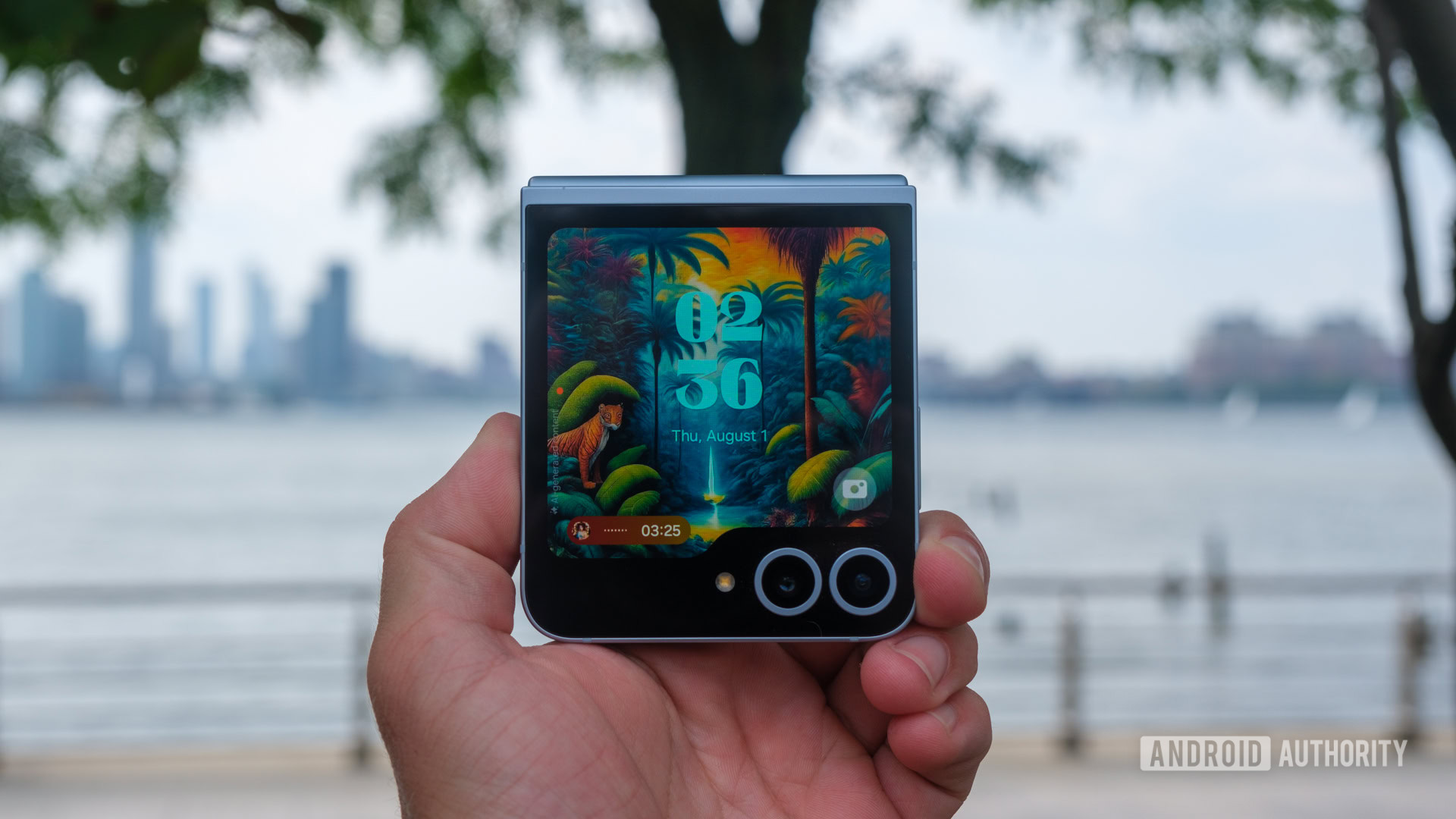
So, as much as I wanted to reach this conclusion and tell you that the Galaxy Z Flip 6 is a good flip phone but not the one I’d buy, I’m not sure I can do that. Even though the 2024 Razr Plus feels more comfortable in the hand, charges faster, and has an easier cover screen experience to jump into, I’m not sure that it’s as obvious of a decision as I first thought. I still feel that I’ve had more fun with Motorola’s latest flagship flip phone in my pocket this year, but I’ve come around to the fact that you just might get more bang for your buck from Samsung.
Sure, there are the obvious advantages, like the longer software update commitment (the Galaxy Z Flip 6 is lined up for seven years), more powerful chipset, and better durability, but Samsung also swayed me with things I thought I’d prefer on the Razr Plus (2024) ($799.99 at Amazon). I finally realized that my lofty dreams of a telephoto sensor on a flip phone shouldn’t come at the cost of an ultrawide camera and that maybe, just maybe, there are some practical uses for Galaxy AI that don’t involve turning people into cartoons — there’s also no doubting Samsung is ahead in the AI game compared to Motorola, which only offers a few basic features.
If you want the very best flagship flip phone, the Galaxy Z Flip 6 is it.
Of course, there are still areas where Samsung’s (now) $1,100 flip phone falls short. It still charges relatively slowly at just 25W, compared to the Razr Plus’ 45W. It still suffers from a locked-down Flex Window experience that has a few too many hoops to jump through. And its surgically precise side rails aren’t that comfortable to hold onto for long stretches — especially when the phone warms up after a long stretch of gaming. Yet, it’s a much better phone than I initially wanted it to be, and it’s an easier one to recommend than I expected.
But really, if you want a foldable phone in the US that’s extremely easy to recommend against the Galaxy Z Flip 6, it’s not a flagship-tier phone at all, it’s the base Razr (2024) ($699 at Amazon). It not only has a more sensible wide and ultrawide camera pairing, but it starts at just $699, which, to me, is more than enough of a discount to offset some of the performance you give up by swapping to the Dimensity 7300X chipset. Motorola’s more affordable flip phone has battery advantages over the Galaxy Z Flip 6, too, with a 4,200mAh cell and 30W wired speeds. Again, you’ll have to wait a little longer for some Moto AI features, but that might be better than paying extra for the promise of Galaxy AI, and paying extra full stop.

